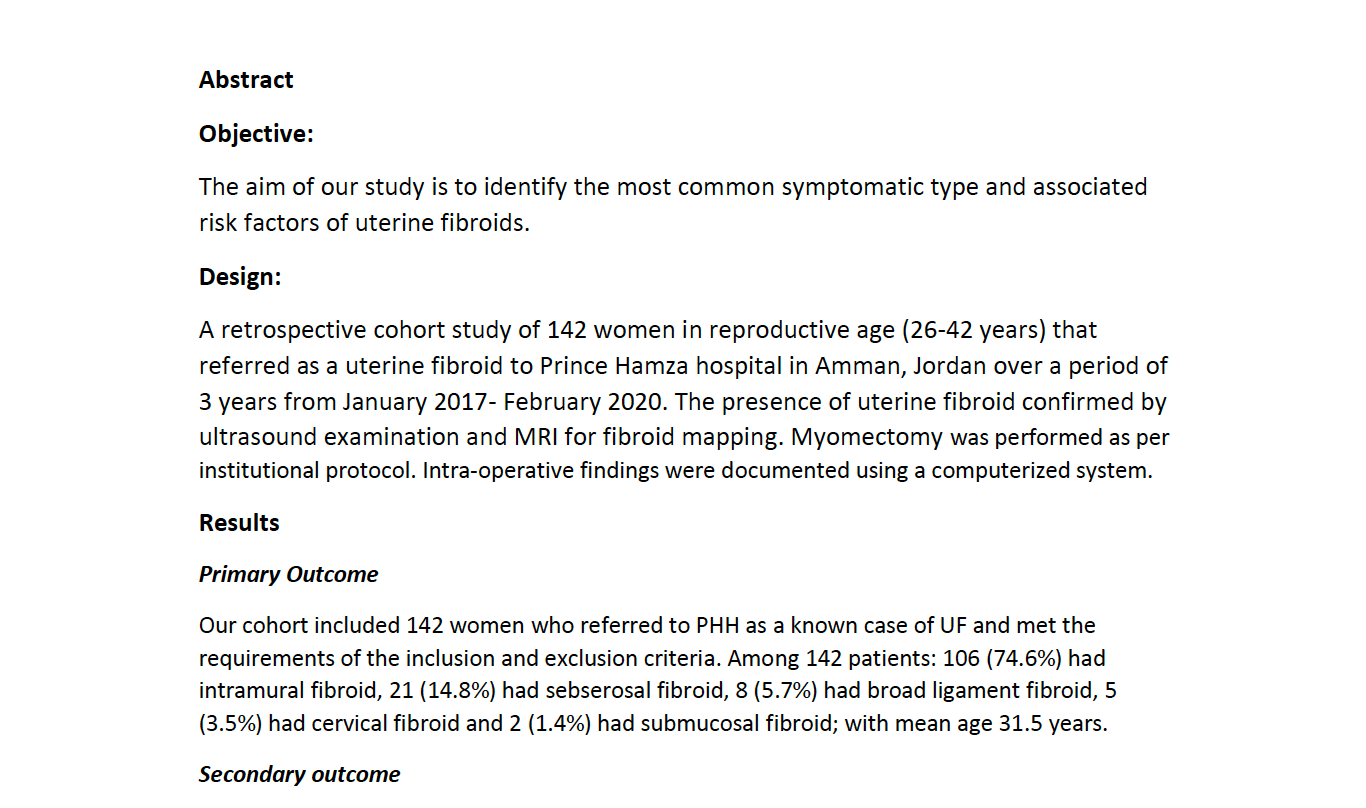Symptoms and risk factors of uterine fibroids
The two most common symptomatic types of uterine fibroids (UFs) are intramural and subserosal, according to an unpublished study from Jordan.
The retrospective cohort study also found that the two most prevalent indications for surgical management of UFs are abnormal uterine bleeding and infertility.
Similarly, obesity and polycystic ovarian syndrome (PCOS) were the two most common risk factors for UFs.
Firas Al-Rshoud, MD

“Uterine fibroids are a very common condition that we see in our daily practice,” said principal investigator Firas Al-Rshoud, MD, an assistant professor of reproductive medicine and infertility, Faculty of Medicine, The Hashemite University in Zarqa, Jordan. “Therefore, we believe more research studies are needed to fully understand this condition, especially the associated risk factors, to hopefully reduce the incidence of uterine fibroids and raise global awareness about these risk factors.”
The study recruited 142 women of reproductive age (26 to 42 years old, mean age 31.5) who were referred for a UF to Prince Hamza Hospital in Amman, Jordan, over a period of 3 years from January 2017 to February 2020.
Table 1The presence of a uterine fibroid was confirmed by ultrasound examination and magnetic resonance imaging (MRI) for fibroid mapping. Specifically, 69.7% of patients were diagnosed by abdominal ultrasound, 28.9% by transvaginal ultrasound and 19.7% underwent additionally MRI for mapping.
Among the cohort, 74.6% had intramural fibroid, 14.8% had subserosal fibroid, 5.7% had broad ligament fibroid, 3.5% had cervical fibroid and 1.4% had submucosal fibroid.
Clinical evaluation demonstrated that 69% of the cohort presented with abnormal uterine bleeding, 49.3% with infertility (primary and secondary) and 39.4% with congestive dysmenorrhea.
The greatest associated risk factor was obesity (44.4% of the cohort), followed by PCOS (31.7%) and nulliparous with a mean age of menarche of 12 years (2.2%).
“The most surprising result of our study is that obesity is the most common associated risk factor, not PCOS as we expected,” Al-Rshoud told Contemporary OB/GYN. “Hence, we hope clinicians will offer weight-reduction counseling to any patient at risk for uterine fibroids.”
The investigators advise women of reproductive age to maintain an ideal body mass index (BMI) of between 19 and 29. “And for those who are obese, to lose weight through diet and exercise as a first step to reduce their risk of uterine fibroids and other unwanted gynecological pathologies,” Al-Rshoud said.
All patients underwent surgical management: 95% myomectomy (all abdominal except two cases of hysteroscopy), 2.8% uterine artery embolization and 2.2% total abdominal hysterectomy.
“Management decisions were influenced by the patient’s desire to preserve their fertility status and the long-term outcomes of the various surgeries,” Al-Rshoud said.
Limitations of the study included the relatively small number of patients and that they were all symptomatic and treated surgically.
___
Al-Rshoud reports no relevant financial disclosures.
Al-Rshoud F, Al-asali F, Kilani R, et al. Uterine fibroids: the most common symptomatic type and associated risk factors, a retrospective cohort study.
Click here for a full PDF of the study manuscript:
Pap Talk S4E4: RFA and uterine fibroids with Dr. Jessica Shepherd
March 30th 2022In this episode of Pap Talk, Jessica Shepherd, MD, MBA, FACOG, deep dives into the benefits of utilizing radio frequency ablation (RFA) for treatment of uterine fibroids, available RFA devices, and disparities in the condition.
Listen
Laparoscopic RFA linked to enhanced pregnancy outcomes in uterine fibroid patients
May 18th 2024A recent study presented at the 2024 ACOG Clinical and Scientific Meeting reveals that laparoscopic radiofrequency ablation significantly improves pregnancy outcomes for women with uterine leiomyomas.
Read More
Physician-patient collaboration for uterine fibroid treatment options
May 12th 2021Contemporary OB/GYN®’s senior editor Angie DeRosa sat down with Ayman Al-Hendy, MD, and Sateria Venable of The Fibroid Foundation, to discuss the role of patient-physician collaboration in uterine fibroid treatment and management options.
Listen
Study finds antihypertensive treatment reduces uterine fibroids risk
April 23rd 2024A recent study revealed that patients with untreated or new-onset hypertension face elevated chances of uterine fibroid diagnosis, underscoring the potential of antihypertensive therapy in mitigating this risk among midlife individuals.
Read More
Genetics associated with reproductive traits and uterine leiomyomata
April 17th 2024Investigating genetic correlations and shared loci sheds light on potential causal relationships between reproductive traits and uterine leiomyomata, offering insights into their complex interplay and urging further mechanistic exploration.
Read More

